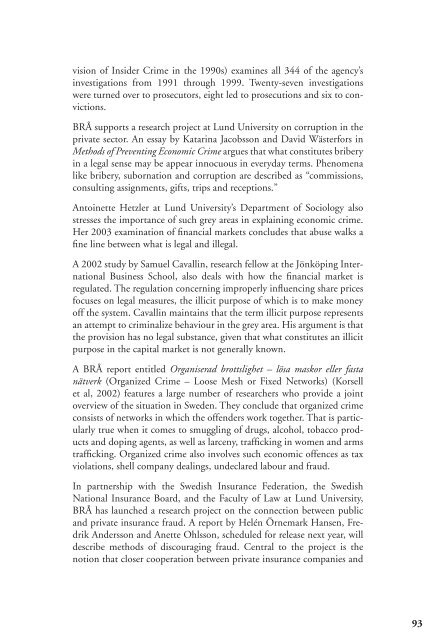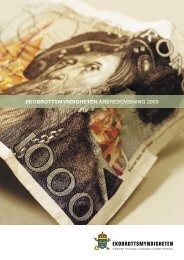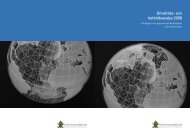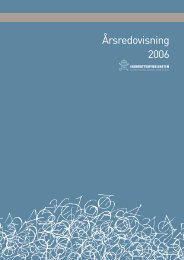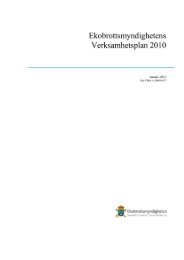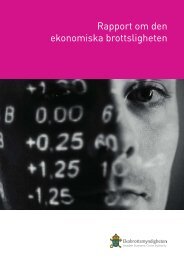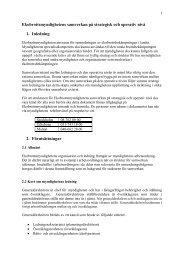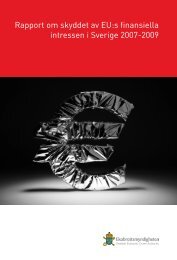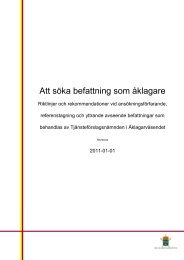Economic crime report 2004 - Ekobrottsmyndigheten
Economic crime report 2004 - Ekobrottsmyndigheten
Economic crime report 2004 - Ekobrottsmyndigheten
Create successful ePaper yourself
Turn your PDF publications into a flip-book with our unique Google optimized e-Paper software.
vision of Insider Crime in the 1990s) examines all 344 of the agency’s<br />
investigations from 1991 through 1999. Twenty-seven investigations<br />
were turned over to prosecutors, eight led to prosecutions and six to convictions.<br />
BRÅ supports a research project at Lund University on corruption in the<br />
private sector. An essay by Katarina Jacobsson and David Wästerfors in<br />
Methods of Preventing <strong>Economic</strong> Crime argues that what constitutes bribery<br />
in a legal sense may be appear innocuous in everyday terms. Phenomena<br />
like bribery, subornation and corruption are described as “commissions,<br />
consulting assignments, gifts, trips and receptions.”<br />
Antoinette Hetzler at Lund University’s Department of Sociology also<br />
stresses the importance of such grey areas in explaining economic <strong>crime</strong>.<br />
Her 2003 examination of financial markets concludes that abuse walks a<br />
fine line between what is legal and illegal.<br />
A 2002 study by Samuel Cavallin, research fellow at the Jönköping International<br />
Business School, also deals with how the financial market is<br />
regulated. The regulation concerning improperly influencing share prices<br />
focuses on legal measures, the illicit purpose of which is to make money<br />
off the system. Cavallin maintains that the term illicit purpose represents<br />
an attempt to criminalize behaviour in the grey area. His argument is that<br />
the provision has no legal substance, given that what constitutes an illicit<br />
purpose in the capital market is not generally known.<br />
A BRÅ <strong>report</strong> entitled Organiserad brottslighet – lösa maskor eller fasta<br />
nätverk (Organized Crime – Loose Mesh or Fixed Networks) (Korsell<br />
et al, 2002) features a large number of researchers who provide a joint<br />
overview of the situation in Sweden. They conclude that organized <strong>crime</strong><br />
consists of networks in which the offenders work together. That is particularly<br />
true when it comes to smuggling of drugs, alcohol, tobacco products<br />
and doping agents, as well as larceny, trafficking in women and arms<br />
trafficking. Organized <strong>crime</strong> also involves such economic offences as tax<br />
violations, shell company dealings, undeclared labour and fraud.<br />
In partnership with the Swedish Insurance Federation, the Swedish<br />
National Insurance Board, and the Faculty of Law at Lund University,<br />
BRÅ has launched a research project on the connection between public<br />
and private insurance fraud. A <strong>report</strong> by Helén Örnemark Hansen, Fredrik<br />
Andersson and Anette Ohlsson, scheduled for release next year, will<br />
describe methods of discouraging fraud. Central to the project is the<br />
notion that closer cooperation between private insurance companies and<br />
93


